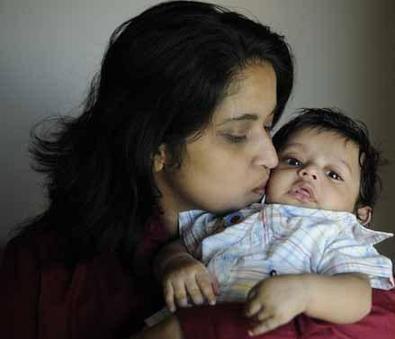加拿大全球健康研究中心的一个研究小组近日发表的研究报告称,在过去30年间,印度有1200万女性胎儿被流产,而这些胎儿所在的多数为受过良好教育且较为富有的家庭,因为他们了解超声波技术而且有能力支付手术费用。研究人员发现,女性胎儿被流产多发生在头胎为女孩的家庭,2005年,这些家庭中二胎男女比例为1000:836,而在1990年,这个比例还是1000:906。研究人员还警告说,越来越多的妇女选择只生一个孩子,而重男轻女的思想在印度又根深蒂固,这样头胎女孩被流产的几率在未来有可能会增加。

 |
|
Up to 12 million girls were aborted over the last three decades in India by parents that tended to be richer and more educated, a large study in India found. |
Up to 12 million girls were aborted over the last three decades in India by parents that tended to be richer and more educated, a large study in India found, and researchers warned that the figure could rise with falling fertility rates.
The missing daughters occurred mostly in families which already had a first born daughter. Although the preference for boys runs across Indian society, the abortions were more likely to be carried out by educated parents who were aware of ultrasound technology and who could afford abortions.
"The number of girls being aborted is increasing and may have reached 12 million with the lower estimate of 4 million over the last three decades," said lead author Professor Prabhat Jha at the Center for Global Health Research in Toronto, Canada.
"The logic is families are saying if Nature gives us a first boy, then we don't do anything. But if Nature gives a first girl then perhaps we would consider ultrasound testing and selective abortion for the subsequent children," he told Reuters in a telephone interview on Tuesday.
Jha said the preference for boys in Indian society remains firmly in place and the reason why abortions of female fetuses were occurring more among richer and educated parents was because they could afford to do so.
"The preference for boys doesn't differ between rich and poor, it is similar. But the means to ensure a boy is greater among the educated and the rich," Jha said.
"In India, if urban women decide they only want one child, then abortion may spread from second or third child to the first, so this is a future risk that we have identified," Jha said.
Jha's team analyzed data from three national health surveys conducted over different time periods from 1992 to 2006, where over 300,000 mothers between the ages of 15 to 49 were interviewed for their birth history.
The researchers also analyzed data of three cohorts of children born from 1990 to 2005.
They found the sex ratio for the second child in homes where the first born was a girl fell to 836 girls for every 1,000 boys in 2005, from 906 to every 1,000 boys in 1990.
"There were 4 million to 12 million selective abortions from 1980 to 2010 and just in the last decade, about 3 to 6 million, so the problem is increasing," Jha said.
India enacted a law in 1996 to prevent the use of scanning for prenatal sex determination and selective abortion of girls but Jha said it was very difficult to enforce because of a huge unregulated private medical practice.
"Until the government brings health reforms in place and brings doctors into a publicly financed accountable system, it's difficult to go that route," he said.
相关阅读
(Agencies)

(中国日报网英语点津 Helen 编辑)